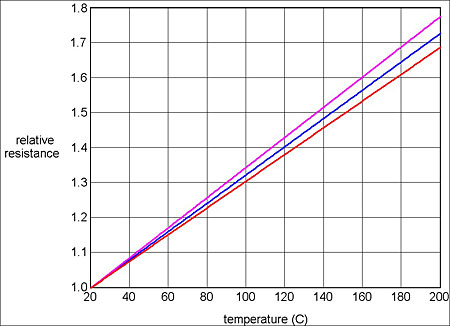It may have to do with more air moving past the outside casing at higher speeds or the oil is pumping around the insides better at full speed.
OK, don't use brake fluid. Thanks Bigmoose.
Here's some interesting info on silicone oil:
http://www.clearcoproducts.com/standard_pure_silicones.html
"Clearco Low Viscosity Pure Silicone fluids are clear, colorless, and odorless
% linear polydimethylsiloxanes (CAS# 63148-62-9) They range in viscosity from 5cSt to 20cSt (centistokes) and are characterized by their low pour points, low surface tensions, low viscosity change at temperature (VTC), excellent lubricity, high dielectric strength, high damping action, wide service temperature range and inertness to virtually all substates.
Clearco Low Viscosity Silicone Fluids also possess high resistance to shear, high water repellency, low vapor pressure, and low reactivity. They are excellent lubricants for plastics, foams and rubbers. Due to their low pour points and low V.T.C. (viscosity change at temperature), they are excellent choices for low temperature bath fluids
Properties:
•Low viscosity polydimethylsiloxane fluids..slightly thicker than water
•Low pour points (as low as -100°C)
•Excellent Low Temperature Stability
•More Thermally stable than the Super-low viscosities
•Low surface tension fluids (high spreadability)
•Low viscosity change at temperature (low VTC)
•Inert to virtually all o-rings, gaskets, seals and valves *
•High Dielectric Strength
•INCI Name: Dimethicone
•California VOC Exempt
* not recommended for silicone rubber due to possibility of swelling
Hmm... not sure what it would do to silicone glue?
Definitely need some kind of vent or air expanding with temperature will pressurize the housing and force a leak.
Oil will be good for those solid steel gears, or any gears for that matter.
Power steering fluid might be another possibility. Based on my garage testing, it seems to be a little thinner than ATF.
OK, don't use brake fluid. Thanks Bigmoose.
Here's some interesting info on silicone oil:
http://www.clearcoproducts.com/standard_pure_silicones.html
"Clearco Low Viscosity Pure Silicone fluids are clear, colorless, and odorless
% linear polydimethylsiloxanes (CAS# 63148-62-9) They range in viscosity from 5cSt to 20cSt (centistokes) and are characterized by their low pour points, low surface tensions, low viscosity change at temperature (VTC), excellent lubricity, high dielectric strength, high damping action, wide service temperature range and inertness to virtually all substates.
Clearco Low Viscosity Silicone Fluids also possess high resistance to shear, high water repellency, low vapor pressure, and low reactivity. They are excellent lubricants for plastics, foams and rubbers. Due to their low pour points and low V.T.C. (viscosity change at temperature), they are excellent choices for low temperature bath fluids
Properties:
•Low viscosity polydimethylsiloxane fluids..slightly thicker than water
•Low pour points (as low as -100°C)
•Excellent Low Temperature Stability
•More Thermally stable than the Super-low viscosities
•Low surface tension fluids (high spreadability)
•Low viscosity change at temperature (low VTC)
•Inert to virtually all o-rings, gaskets, seals and valves *
•High Dielectric Strength
•INCI Name: Dimethicone
•California VOC Exempt
* not recommended for silicone rubber due to possibility of swelling
Hmm... not sure what it would do to silicone glue?
Definitely need some kind of vent or air expanding with temperature will pressurize the housing and force a leak.
Oil will be good for those solid steel gears, or any gears for that matter.
Power steering fluid might be another possibility. Based on my garage testing, it seems to be a little thinner than ATF.





